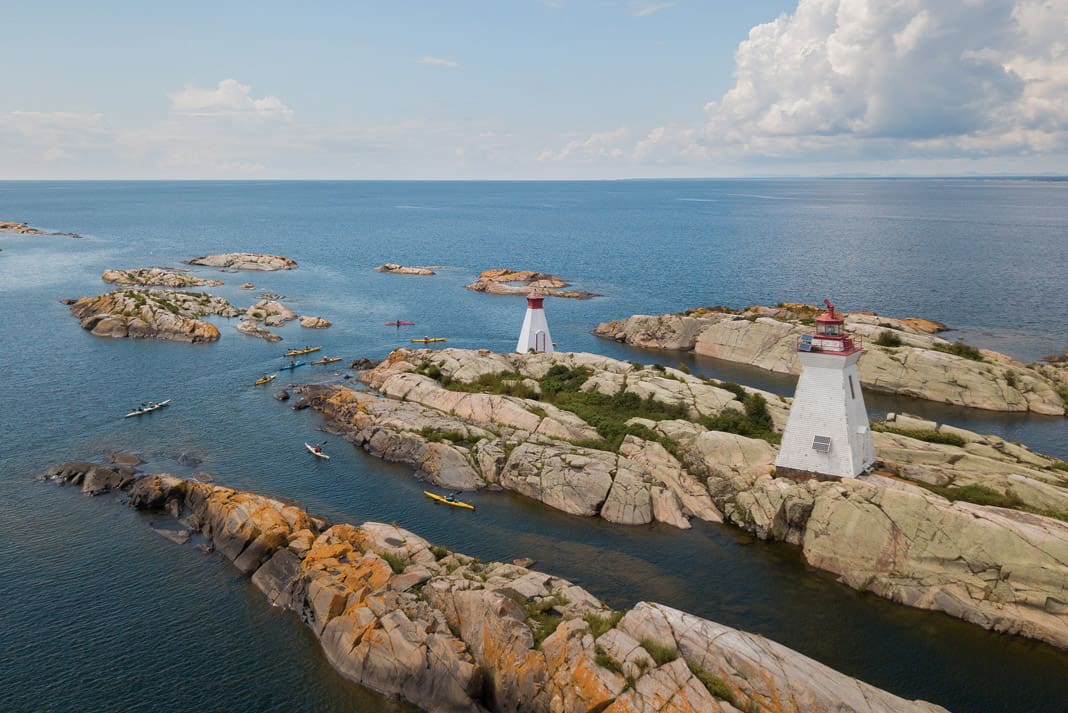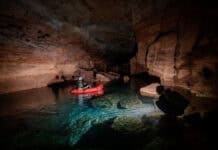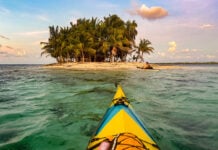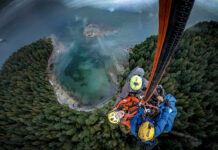Seconds after taking this shot, I panicked. The screen displaying my drone’s camera view went black. Completely. No battery levels. No GPS. No map. Nothing. I couldn’t see what the camera on the quadcopter saw. In fact, from where I was standing, I couldn’t even see the tiny black speck of the drone in the sky.
While I’ve resigned myself to the possibility of someday losing a drone—it hasn’t happened yet, knock on wood—it was the memory card I was most concerned about. It had on it nearly five days and 10 flights worth of photos on it. Rookie move. Suddenly the $40 memory card seemed more valuable than the camera and rig itself.
This was a trip I’d wanted to take for years. Over several days we’d paddled up the eastern shoreline of Georgian Bay, from Key River to the tiny town of Killarney. I knew this route would be a photographer’s dream.
Every few kilometers of travel rewarded us with new vistas. Islands of grey and pink Shield granite peaked out from the azure blue water, contrasting with the bright orange lichen growing onshore. Under warm August sunshine, I felt I was paddling in a Caribbean island chain—it was paradise in a freshwater sea, complete with warm water for endless swimming.
With no idea where the drone was, I pressed the panic button and waited
I wanted to paddle here to take pictures. The idea of a drone shot near the Chicken Islands, lighthouses in view, had me excited. While flying a drone is pretty easy these days and anyone could take an amazing shot from 300 feet up in this area, getting your gear to work in a spot like this is difficult. Spending seven days in the wilderness while maintaining enough power to make multiple flights per day isn’t easy. My secret? A behemoth battery weighing 28 pounds, which just barely fits in the rear hatch of my kayak. Combine the battery with a foldable solar panel and I can keep all my drone batteries charged for days. So long as it’s sunny.
Of course, my massive power source was also worthless if my drone ended up in the drink. As I scanned the bright sky for a tiny speck of airborne black plastic, I remembered the button on the controller I had never pressed before, marked simply with the letters RTH.
With no idea where the drone was, I pressed the panic button and waited. I was just less than a kilometer from the Chicken Island lighthouses and my drone was somewhere over that-a-way.
After a few minutes, I heard the familiar swarm-of-bees heralding its arrival and spotted a black smudge in the sky headed my way. I retook control and landed it easily on the rocks beside me. After a few celebratory cuss words, I mentally thanked whoever designed this RTH button.
You know what I did next? I switched out my memory cards. Because in my humble opinion, the tiny 16 gigabyte SD card containing this photo was as valuable as newfound treasure.
Feature photo: Colin Field









Being a guy that loves photography, and toys, and technology, I’m wondering what hte issue turned out to be.
Also, so glad that you were able to recover your drone and memory card. I’ve heard of a few times where that wasn’t the case.
Backup is one of the hard lessons. Nowadays’s it’s not just a backup drive, but more importantly cloud storage. Even better is automatic cloud storage.
That’s a lesson also learned from the ground-based digital photographers. When the larger capacity memory cards started appearing, many photographers made the switch, shooting until they were filled. It wasn’t too long before a card or two failed or was otherwise corrupted, with the obvious results. I’d learned from the mistakes of others, and thanks for showing that it’s not just the cards’ failures we have to consider. Mostly, I’m glad you’d recovered your images!